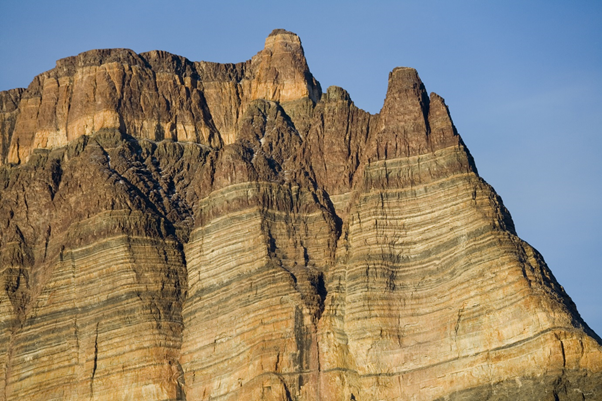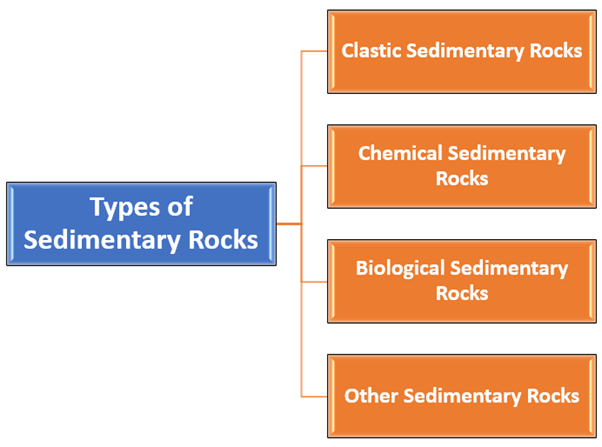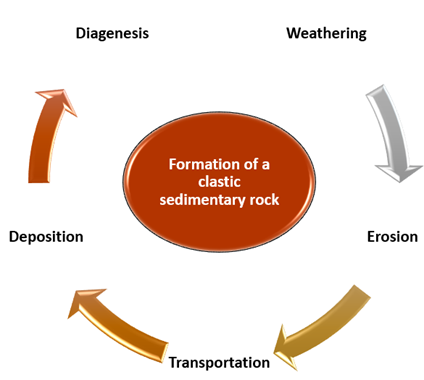What is a Sedimentary Rock?

Source: © Mrallen | Megapixl.com
Sedimentary rock is one of the three main types of rocks present on the earth's surface. These types of rocks are formed on or near the earth's surface, while metamorphic and igneous rocks are formed below the surface of the earth. These rocks are formed by fragments of pre-existing rock and fossils.
Erosion, weathering, transportation, deposition, and lithification are the major steps in converting clastic sediments into sedimentary rocks. Sedimentary rocks are the ultimate source of fossil fuels, drinking water, ores and coal. The study of the sedimentary sequence also tells us about the history of the earth.
What are the different types of sedimentary rocks?
Based on the origin, sedimentary rocks can be classified into four major groups. Let us have a look at them one by one.

Source: Copyright © 2021 Kalkine Media
Clastic Sedimentary Rocks: The accumulation and lithification of debris forms these rocks. These rocks are made up of clasts of pre-existing rocks. Rock pieces are weathered and transported to a low-lying area after erosion. The sediments get deposited into the basin and gets cemented, forming sedimentary rock.
Chemical Sedimentary Rocks: These rocks are formed by the precipitation of dissolved material from the solution. This is the most common process for the formation of chemical sedimentary rocks. The rocks, which are made up of gypsum and halite, are known as evaporites. The precipitation of minerals forms limestones out of water due to change in the temperature of the water. Limestones are generally formed in the oceans.
Biological Sedimentary Rocks: Biological sedimentary rocks are formed by decaying a large number of living organisms. Most of the biogenic sedimentary rocks are formed as marine organisms such as corals and molluscs. The organisms precipitate calcite and other carbonate minerals from water to create their shells.
Other Sedimentary Rocks: The fourth category of sedimentary rocks contains miscellaneous rocks, including volcanic breccias and volcanic tuff. These are formed by the decomposition and cementation of lava fragments that are erupted by volcanos.
Summary
- Sedimentary rock is one of the three main types of rocks present on the earth's surface.
- These rocks are formed above or near the earth's surface by the fragments of pre-existing rocks and fossils.
- Clastic, chemical and biological are the three major categories of sedimentary rocks, whereas miscellaneous rocks are also found.
Frequently Asked Questions (FAQs):
What is the process of formation of a clastic sedimentary rock?
There are five major steps involved in the formation of a clastic sedimentary rock. Let us have a look at each step briefly.

Source: Copyright © 2021 Kalkine Media
- Weathering: Weathering is the most basic step in the formation of a clastic sedimentary rock. The step transforms solid rocks into fragments by physical and chemical weathering.
- Erosion: Erosion is the process of beginning the transportation of weathered product from the place of origin. The transportation of the product takes place by the action of running water, wind, gravity and moving ice.
- Transportation: After erosion, sediments are the transportation of sediments that take place by sliding slopes, the action of winds, river, streams and ocean currents.
- Deposition: Followed by transportation, sediments are deposited as soon as the energy of transportation becomes low. If the velocity of the transporting medium becomes low, the sediments become deposited.
- Diagenesis: Diagenesis is the process of conversion of sediments into rocks. Compaction is the primary stage of diagenesis which takes place due to the overburden. Compaction reduces pore space and reduces the water content. The water carries mineral content in the form of a solution, and these minerals get precipitated in pore space to cause cementation to bind particles together.
How can sedimentary rocks be classified based on composition?
Sedimentary rocks can be classified based on their mineralogical composition. Let us have a look at their types briefly.
- Siliciclastic Sedimentary Rocks: These rocks have silicate minerals as their major composition. The sediment constituents of these rocks are transported as suspended load or bed load of the river. Breccia, sandstone, mudrocks and conglomerates are the major examples of siliciclastic rocks.
- Carbonate Sedimentary Rocks: The main composition of sedimentary carbonate rocks are aragonite, calcite, dolomite and other carbonate minerals. Dolomite and Limestone are the common examples of these types.
- Evaporite Sedimentary Rocks: The evaporation of water forms evaporite Sedimentary Rocks. Sulphates, chlorites and carbonates are the common mineral composition of evaporite sedimentary rocks. These rocks commonly include gypsum, anhydrite and halite.
- Organic Sedimentary Rocks: The sedimentary rocks that contain more than 3 per cent total organic carbons are known as organic-rich sedimentary rocks. Oil shale and coal are some examples of organic sedimentary rocks.
- Siliceous Sedimentary Rocks: Silica is the main component of these rocks. Chalcedony, chert and opal are some examples of these rocks.
- Iron-Rich Sedimentary Rocks: These rocks contain more than 15 per cent iron. Ironstones are the most common types of these rocks.
- Phosphatic Sedimentary Rocks: Phosphatic sedimentary rocks contain more than 6.5 per cent phosphorous. Phosphatic mudrocks, bone beds and phosphate nodules are some of the major examples of Phosphatic sedimentary rocks.
What is the importance of sedimentary rocks?
Sedimentary rocks have various advantages. Let us discuss the most important advantages one by one:
- Sedimentary rocks are the major source of natural resources like oil, gas, coal, uranium etc.
- Sedimentary rocks like sand and gravel are used for construction purpose.
- Sedimentary rocks can also be used to reveal the earth's history by determining the ancient current directions.
- Phosphate sedimentary rocks are used for fertilizers, and quartz is used in the manufacturing of glass.
- Limestone is used for the manufacturing of cement.
 Please wait processing your request...
Please wait processing your request...